Looking for a campsite in the Adirondack backcountry is neither science nor art, it is a struggle, especially so within the remote southwestern Five Ponds Wilderness. The chance of finding one of those flat areas so common along the trail system, devoid of vegetation and other debris due to many years of human use, is impossible in an area that gets only several visitors every year. A small site just big enough for my tarp, which will not leave me with a contorted spine the next morning, is about all I can wish for under the circumstances.
With my day’s goal of reaching the confluence along the Middle Branch of the Oswegatchie River complete, the late hour brings on other priorities, namely finding a campsite for the night that does not contort my back too much. Before doing so, addressing an even more urgent task demands precedence, that is, finding a proper place for a serious voiding of my bowels.
Surveying the surroundings in my immediate vicinity near the confluence, these duel tasks appear totally incompatible with the area. Where once I viewed a flat plateau upon my arrival, perfect for a campsite, there is now an uneven forest floor covered with numerous small logs, crisscrossed on top of each other. Behind this disaster area lies a soggy depression, while further from the water, a nearly cliff-like rise. As a co-worker once said, the place reminded me of why people live in houses.
As far as being campsite and dump friendly, this place left much to be desired.
View Day Two, Part Four in a larger map
Section Stats:
Date: June 18, 2013
Length: 1.4 miles (3.7 total daily miles; 7.0 total trip miles)
Difficulty: Moderate
My current predicament sent my mind in motion, contemplating all the possible scenarios where I could relieve the gnawing pressure in my bowels as well as find an acceptable camping site. Struggling through a steep retreat back onto the ridge that I just descended was the only option for relieving myself if I decide to stay here. After doing so, finding a campsite near enough to the water seems a tremendous challenge, and that is putting it mildly.
Unwisely, I push on further north, bushwhacking along the confluence in search of a more adequate campsite, as well as a respite for the growing pressure within me. From out on the little peninsula where I viewed the confluence in all its glory, the northwestern shore appeared promising, although the possibility that it is just wishful thinking remains in the forefront of my thinking.
As I continue my way northward, I do my best to hug the shoreline, although somewhat back in the forest a good distance, occasionally moving further away when the surrounding thickness demands it. Thick young spruce/fir impede my progress closer to the open water, so I am left with no choice but to stay back in the forest for most of the way.
Unfortunately, no accommodating forest conditions appear, forcing me to continue bushwhacking northward leaving me further and further from the confluence as it angles off to the northeast. As the only open water fit for filtering becomes farther off to the east, the available options spin around in my brain.
Referencing my Garmin eTrex Legend GPS, my position is now north of the confluence’s open water, locating me parallel to it boggy northern portion. Heading back and hoping to find a campsite to the south, or continuing on to the next small pond to the north are my only remaining options now. Since not a single adequate camping site presented itself on my sojourn thus far, searching near the northern pond appears the only viable option. I just hope my large intestine does not explode in the meantime.
Soon, I cross a flattish area perfect for making camp, but alas, the nearest open water is way too far off to be of much use to me. A clearing appears up ahead through the trees, so I turn westward in an attempt to avoid risking a wet meadow, realizing with every step I am draw closer to a high ridge running northeast that leads directly to the next pond. Although the ascent up the ridge should provide little in the way of nice camping sites, the forest along its eastern slope should contain less coniferous trees to thwart my efforts.
Anything allowing for faster bushwhacking may make all the difference between arriving at a dependable water source before sundown.
Before reaching the steeper terrain near the ridge, the level area gives me the opportunity to not only drop my backpack for a rest, but also the bothersome load in my intestine that accompanied me all the way from the southern tip of the confluence. After the sweet relief of relieving myself of this encumbering burden, my bushwhacking becomes more effortless, as if there is a new spring to my step.
While vaulting through the forest toward the beginning rise of the ridge, my eyes catch sight of a whitish spot upslope from my location. Despite being a half hour past my make-camp time, my curiosity gets the best of me, and I climb the rise to check out this odd anomaly.
As I draw close to it, the mystery of its identity vanishes. Another Mylar balloon, grounded after a flight from who-knows-where, many miles from the nearest birthday party, gives the term leaf-litter a completely new meaning. After taking a couple photographs, I collect the pinkish balloon, now turned almost white by its exposure to the elements. The color change indicates it probably laid here for a relatively long time before it finally ended up in my garbage bag.
Upon collecting the balloon, I continue bushwhacking northeast, climbing up along the side of the ridgeline as I go. As I climb, I notice a pile of moose scat, the first since earlier in the day. This starts my mind woolgathering as I plod along, fantasizing about finally catching sight of my second Adirondack moose while bushwhacking near the end of the day.
Although, as the Sun continues falling behind the ridgeline, the chance of catching sight of a moose decreases dramatically along with my ability to see off into the distance through the trees. The diminished lighting increases the length and darkness of the shadows around me, giving the surrounding forest a maliciously threatening demeanor. This probably accounts for my increasing pace, which I continuously find myself moderating to avoid increasing the probability of an accident or worse.
Progress comes easier up on the ridge, the deciduous forest allowing for a quicker pace, despite hiking along a slope and through frequent patches of witchhopple. Apparently, the progress is too easily had, as my GPS indicates I went too far north, almost leaving the small pond behind in my wake. Turning due east, I begin my exodus from the ridge, and start the last stretch of my torturous late day hike toward the small pond north of the confluence.
My exhaustion from the long day creeps up on me, leading to more tripping over witchhobble and other shrubbery. As I continue my descent, the sudden crash of witchhobble startles me from my fatigue-induced revelry, allowing me to view a rare sight within the Adirondacks. A white-tailed deer bounding up the slope and away from me, whereupon reaching a safe distance upslope, it stops and turns its head back toward my location. The quizzical way it peers at me suggests this might be its first encounter with a human being, which is pretty likely given my distance from any semblance of civilization. I hope it does not think we all smell this bad.
The later hour, well past my usual campsite time of five in the afternoon, compels me forward at a swifter pace. Running through my mind, I check off all the many chores left to do before the end of the day: filter water, hang food, set up tarp, coo dinner, brush teeth, etc. This does not improve my sense of impatience any, but I cannot seem to refrain from torturing myself.
At first, I fail noticing the faint sound over the tumult of my movement through the forest. When it becomes louder, I frequently stop and listen, unsure whether it is just a figment of my desperate imagination. Finally, as the source grows closer, the sound is undeniable, so I pick up my pace even more so than before, my eagerness overcoming all sense of reservation.
The stream remains largely hidden within the rough terrain and lush vegetation, although the jumble of leaf-litter covered rocks betrays its location. According to the map, this stream’s source is even further north, a pond that I will be visiting in a couple days from now. The streams destination lies in front of me, obviously located in the clearing slowly opening up in front of me.
Seeing the tall grass and snags through the trees, out in what apparently is open water, I abandon all hope of having a picturesque setting near a rock-covered shore of an attractive glacial lake. My levels of exhaustion from the long and arduous day reaches new depths, so as soon as I find a shallow knoll within a grove of scant and scattered spruces, I discard my backpack and decide to call the rather inhospitable place home, thankfully for only a single night.
After the tarp goes up, leaving me free to initiate the next task of filtering water, I discover my campsite is probably a little too close to the stream. Exhausted, I consider moving it elsewhere for only a brief moment, before capitulating and deciding to let campsites lie. Since my plans call for staying overnight before continuing on to Crooked Lake, engaging in no washing or bathing, I manage to convince myself of little impact. Given my great fatigue, it does not take much mental arm-twisting to do so.
Covering all this extra ground today should allow for a shorter day tomorrow, which I could definitely use, even if today is only my first full day in the backcountry. This sudden realization catches me completely by surprise, as it seems like a near-eternity since entering this remote portion of the Five Ponds Wilderness a day ago. Once reaching Crooked Lake, my journey will cease its eastward progression, where I will turn westward as the three-day sojourn back to my vehicle begins.
Foregoing a hot meal, I inhale a peanut butter sandwich and numerous snacks, as setting up the stove is too much for my dwindling energy reserves. As I consume my much needed dinner, hordes of hunger mosquitoes come a-calling, apparently in search of their own dinner.
The long day takes its toll after dinner, so I quickly take care of my after dinner chores, before preparing myself for an early bedtime. Numerous plans roar overhead, high above and often almost out of sight, adding to the natural sounds of the stream nearby and the spring peepers toward the pond nearby.
It is still daylight when I crawl under my tarp for the night, escaping the increasing number of mosquitoes looking for blood. The campsite is vastly less comfortable than it first appeared, now with the fatigue induced foggy glasses removed, but I ignore my protesting back and settle in for the night. It is only for a single night after all, and with any luck, tomorrow’s short journey will allow for selecting a more accommodating campsite.
At least, one can hope.
Affiliate Disclaimer: Some links within this blog post may send you to a retailer website. If you chose to purchase any product on that site at that time, this author receives a small commission. These commissions provide compensation for the author’s time and effort necessary to provide the content at the Bushwhacking Fool.
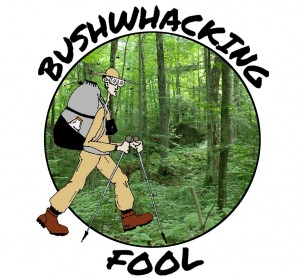
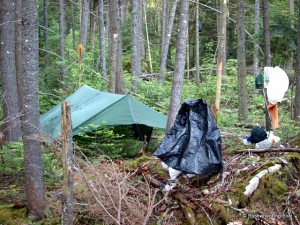
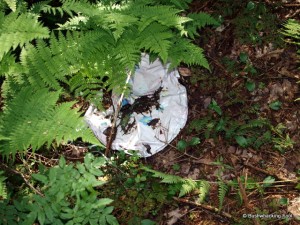
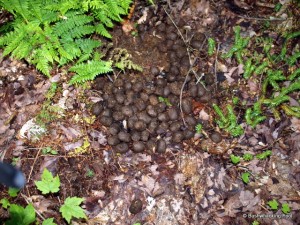
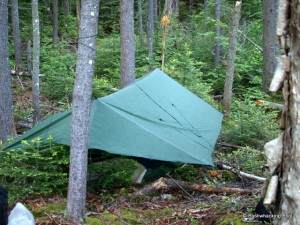



Ed Reese
April 15, 2014 at 9:51 pm
Dan,
These are easily the only photos of this place in existence. I was closer to the middle branch and a little west of there on May 16, 1975. Although, I was in a life threatening situation. As the kid, the Boy Scout training was NOT enough for this kind of woods. I don’t EVER go in alone anymore. When my friends and me go in now, we take our time, and avoid what we know is trouble. When I went through there in 75, I had three shots left in my camera (black & white photos)- 1) Sand Lake, 2) an unnamed creek curving down to Sitz Pond Creek from the east side a hill with lots of rushing water in it, and 3) a small swamp east of Sitz Pond.